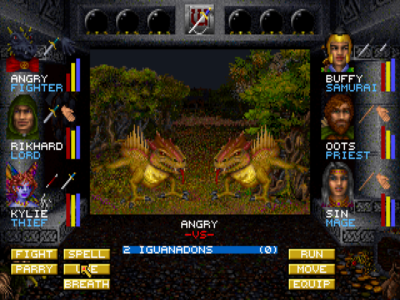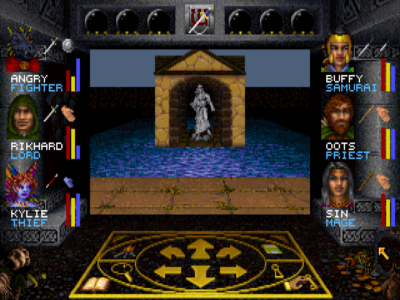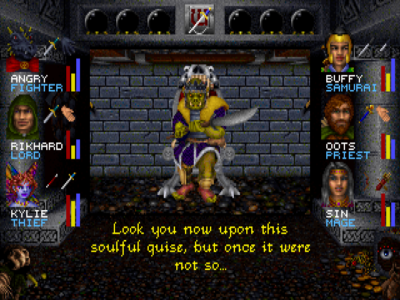
Wizardry: Crusaders of the Dark Savant
Written by: Stoo
Date posted: October 11, 2002
- Genre: RPG
- Developed by: Sir-Tech
- Published by: Sir-Tech
- Year released: 1992
- Our score: 5
Here’s a tribute to wasted childhood. In years gone by I was never actually much of an RPG fan, with the exception of this one which I’ve spent far too much of my life playing. It’s the seventh in the Wizardry series, a venerable line of RPGs which began with boot-loaders back in 1980, continued through to this one in 1992, then had a belated eighth and final outing in 2002. Common features throughout the series are: a team of multiple heroes, first-person perspective and tactical turn-based combat.
Also, if games could have beards, these ones would be full-on Gandalf style. Be warned, we’re talking about plenty of number watching and stat building, with the computer rolling lots of invisible dice behind the scenes to determine the outcome of your actions. Many other RPGs past and present do that too, but some offer features like pretty graphics, realtime action, or a strong narrative to make it all a little more friendly and attractive to the average gamer. None of that here; this is probably one for the fairly hardcore set. Unless like me you just ran across it by accident.
The series doesn’t have one single plot or setting, but is rather distributed across a few different stories. The final three instalments form a trilogy, so this one lands in the middle. Not that you really need to have played the previous game to follow what’s going on. A quick introduction gets you up to speed; some powerful magic item known as the Astral Dominae has been found on a remote planet. Apparently it holds the secrets of creation itself, which is at least one step more exciting than magic gems or swords or whatever. Several powerful factions are interested, including the dreaded Dark Savant himself, an ominous figure commanding legions of androids. Your band of adventurers, on some other unimportant primitive world, is rounded up by another faction to try and claim the item before anyone else does.
The first step in these games is always generating your team of adventurers. In this case, the process is a complete pain in the neck. It’s amazing that I was so forgiving of it in the past. The key points are simple enough; choose race, gender, character class and distribute a few skill points. Classes on offer include basic staples like fighter, mage and thief, and also some more elite types such as Lords (a fighter with access to Priest spells) and Ninjas (can do just about anything). The bad news is, all classes have entry requirements in terms of core attributes like strength, speed etc. Your newly generated characters’ attributes are randomly generated and then a list of possible classes shown. If you don’t see what you want, you’ll have to go through several more steps, then junk the character and start again, So if you want an elite class, you’ll have to try over and over before you get lucky with those virtual dice and “roll” a good enough hero. Which is just bad design, really.
All that established, it’s time to venture out into the wide world of Guardia, which you view through your team’s collective first-person perspective. You’ll never actually see them in-engine; they each exist as a portrait and a set of skills and numbers. Like most other RPGs of the time, the game’s engine is limited to tile-based, entirely flat environments of rooms and corridors. You move in steps of one tile, and turn in steps of ninety degrees.
That’s is pretty much fine for dungeons at least. However there are forested areas too, by which I mean dungeons with the roof off and pictures of trees for the walls. Also cities, composed entirely of one-story buildings. For any kind of scenery or features beyond that, you won’t see anything, just receive text descriptions of what’s around you. You might be told you’re in mountainous areas sometimes, or at the foot of a mighty tower, with little visual evidence of either. While inside buildings you’ll be given descriptions of how a room contains a fireplace, chairs and tapestries, while your view shows only bare walls.
I’m not here to criticise an old game for having old graphics. Rather, noting that it was pretty cheeky of Sir-Tech to try and tell us that this world is quite rich in variety and detail, but show it to us with an engine that reduces everything to bare and square rooms and corridors (with optional ceiling). I suppose you could say that you’re supposed to fill in the gaps yourself using your imagination, same as if you’re reading a book. Still I imagine it would be pretty hard to sell that idea to modern gamers.
The inhabitants of that world meanwhile are at least more original in concept than the usual elves-and-dwarves fare of fantasy RPGs. Some races you meet are natives, others visitors from other worlds; you’ll meet the arrogant bald mystics known as Dane, militaristic Pachyderms of the Umpani, and sinister spider like T’Rang. There’s something of a technology-meets-fantasy theme; the Umpani for example are a spacefaring race, but fight with swords and muskets.
Anyone you encounter, be they friendly characters or monsters, are apparently hidden in floor compartments. As you progress down a corridor or through a field the coast looks clear until suddenly a fanfare rings out and you see a bunch of killer giant beetles lined up before you. It’s another signature feature of a primitive engine, but to be fair the Final Fantasy series was still using a similar method for its random monster encounters, several years later.
Anyway, this leads us neatly onto combat. It uses a system the manual calls “phased”, which is really just a variant on turn-based. At the start of a round you issue orders to each team member: attack with weapon, use a potion, cast Flaming Arse of Death etc. Then you hit “go”, sit back and watch the action. Or rather, watch the monsters continue to mill around whilst text messages tell you that your fighter’s attack missed, your priest drank the potion, an enemy has hit your thief, and the flaming arse has backfired and roasted your Mage. And so on.
It is actually a reasonably tactical affair; hacking up a few giant bugs is simple enough but when faced with several groups of enemies you have a few points to consider. Do you want to focus all your attacks on one enemy group and slow the other down with a sleep spell? Which one to prioritise, the group that’s more dangerous or the one that can be more easily killed? When it comes to magic It’s tempting to just let rip with fireballs, but often more effective to debilitate foes with a paralysis or sleep spell. Or maybe forgo offence to cast something enhancing your own team. You can also arrange their formation; it generally makes sense to have burly warriors at the front and weedier magic users behind.
You should be warned, be prepared to hit reload a lot, when overwhelmed by hordes of monsters. Combat is hard. There’s also a lot of it; some fights are triggered on key locations but they’re also randomly generated on a very regular basis. There’s really no such thing as a safe place, other than when in a given area you’re tough enough to mash the monsters there with ease, as fights can occur just about anywhere. You’re also liable to be routinely disturbed when trying to rest and recuperate. In short, at least 75% of your time in this game will be spent hacking and slashing – but then, that’s really what the game’s all about.
Almost everyone or everything you meet is trying to kill you, so don’t expect crowds of nonchalant peasants or townspeople wandering around. There are however a few non-player characters to meet. Some are shopkeepers, others randomly roaming the wildernesses and cities. You can talk to them via a rudimentary text parser, pick up some hints, trade items etc. Some might not like you too much at first, forcing you to try a “diplomacy” skill (yup, more dice-rolling), bribery or a charm spell. You can however happily be friends with characters who are sworn enemies without upsetting either party. You will sometimes be told NPCs have also been meeting each other, fighting and trading key items, even getting killed. The idea of them taking unscripted actions unrelated to your own is interesting, and something you don’t see a lot of in RPGs, but don’t expect to ever see any of this. You just hear about it from characters you meet.
There is an amount of puzzle-solving here too, to punctuate the sessions of beating monsters to death. Some are actually pretty damn tricky, even. To make life complicated, to get past many of them you need to find certain misleadingly named “maps”. These are in fact documents, each containing cryptic clues on how to solve a certain puzzle. However, the maps don’t remain in their starting place indefinitely; take too long and they will end up in the pockets of an NPC. Who you then have to chase across the world, using a “locate person” spell or getting pointers from local characters. Or you could just cheat.
The game is also reasonably non-linear, which helps maintain some feeling of freedom. There are a number of cities and dungeons containing key objectives; sometimes you need to find certain items or trigger events to gain entry, but often it’s just a case of being tough enough to fight your way there. You can also give up if stuck, find something else to tackle and come back later. Sometimes you might just find yourself bashing monsters for experience; this is a game where it really does help to dedicate time purely to leveling up. Which might sound horrendously dull to you, but then again perhaps not if you’ve actually kept reading this far.
It’s not too strongly story driven, besides the over-arching plot about finding the magic widget. There are however bits and pieces of interesting plot that come your way, regarding the history of the planet and the races vying for control. You’ll find yourself overthrowing a few mighty leaders, witnessing the defeat of a major power and learning more about the powers that created this world. In between killing giant moths and rat-men, anyway. The narrative also tends to go semi-intellectual on you at times, with meandering thoughts on topics like civil war, destiny and the nature of life itself. It’s almost as if the writer had been jotting down scraps of meaningful discussion that sprung to his mind as he went along, and then inserting them at appropriate places in the game.
There are some oldies from ten or more years ago, for which I try to put forward a case for them still being worthwhile for modern gamers. Classics like UFO or System Shock. To be honest, this isn’t one of them. Too dated, too sparse a world, too reliant on text and numbers. The short form is: on paper the world is rich and detailed, the characters varied and lively, and the story full of excitement. It’s just that the presentation of all this is very spartan. Still, I’m sure there are some serious dungeon-crawlers out there who enjoy such things. Those of you who grew up with a love of swords, beards and dice-rolling in games of old (admit it, you know who you are) might still find some enjoyment. It runs in Dosbox so you can always quickly alt-tab away if you’re worried someone will catch you playing such an unfashionable game.





 Posts
Posts
I wrote this way back in the days when we were directly comparing DOS oldies to contemporary games, ruthlessly casting aside dewey-eyed nostalgia. Hence the rather harsh score.
Nowadays I try to strike more of a balance. We’re trying to assess old games on their own merits, seeing how well they accomplished whatever they set out to do. At the same time we have to acknowledge that nowadays we don’t want to deal with all the frustrations of game design from 30 years ago.
So then, I’d be happy to never sit through the charcter creation again. Also I urge you all to just cheat and look up the clues in the “maps”, don’t chase RPGs aroudn the map. On the other hand, all that text in lieu of graphical representation is something actually ok with since the writing is quite evocative. Combat meanwhile can be unforgiving, but less so than early wizardries and it’s satisfying when it all goes right.
So I’d probably rate it a point or two higher; casual RPG fans might not do well but dedicated dungeon crawlers should give a try.
June 2, 2023 @ 4:21 pm